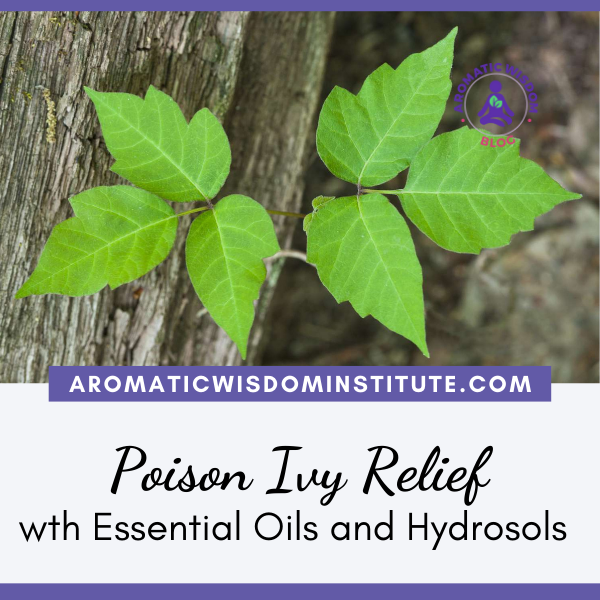🎧 Prefer to listen? AromaticWisdomPodcast.com/65
📖 If you’re more of a reader, dive into the blog post below! 👇
Poison Ivy Relief with Essential Oils and Hydrosols
My Encounter with Poison Ivy
I recently found myself in a battle with poison ivy after tackling the invasive plant in my backyard. Despite my precautions, I ended up with a nasty rash that left me itching and uncomfortable. In this blog post, I’ll share my experience and the remedies I used to soothe the symptoms using essential oils, hydrosols and other natural ingredients.
Understanding Poison Ivy: A Quick Primer
Before diving into remedies, let’s quickly understand poison ivy. It belongs to the Toxicodendron genus and contains urushiol, an oily sap responsible for the irritating allergic reaction in humans. Recognizing poison ivy is crucial; it typically appears with leaves grouped in threes and can be found in various forms—leaves, vines, stems, and roots—all containing urushiol.
Essential Oils and Hydrosols for Relief
When faced with poison ivy, the primary goals are to relieve itching, reduce inflammation, and protect against infection. Here’s how essential oils and hydrosols can help:
1. Relieve the Powerful Itch
The quickest relief for itching comes from Peppermint essential oil. Its menthol content (found in the ketone chemical family) provides a cooling effect that alleviates the itchiness caused by histamine release. Peppermint hydrosol can also be effective, although less potent than the essential oil.
Application Tip: Mix a 3 drops of Peppermint essential oil inside a small container with 1-ounce (30 mL) of fragrance-free lotion and gently apply this blend to the affected areas for immediate relief of the maddening itch. OR spray the affected area with Peppermint Hydrosol and let it air dry.
2. Reducing Swelling and Inflammation
German Chamomile essential oil, Blue Tansy essential oil and Yarrow essential oil are all excellent choices for reducing swelling. These “blue oils” are known for their anti-inflammatory properties when diluted in a carrier oil or lotion. Learn more by listening to the Aromatic Wisdom Podcast episode #54 called The Amazing Blue Essential Oils: Chemistry and Benefits
3. Protecting Against Infection
To protect blisters from infection, consider using Tea Tree essential oil. Tea Tree is a classic healer that offers amazing antiseptic properties that can keep the affected area clean and prevent bacterial growth. Hydrosols like Tea tree, German chamomile, and Helichrysum also aid in soothing inflammation.
Clay-Based Remedies
One highly effective remedy involves using natural clays mixed with Peppermint hydrosol and essential oils like German chamomile. Clay helps draw out toxins and soothes irritated skin, making it a potent natural alternative to commercial products. Here is a soothing cool recipe for calming the itch DIY Recipe for Natural Calamine Lotion.
Identifying Poison Ivy
To avoid future encounters with poison ivy, learn to identify it:
- Leaves of Three: Poison ivy leaves grow in clusters of three leaflets.
- Longer Middle Stem: The middle leaflet has a longer stem compared to the two side leaflets.
- Hairy Vine No Friend of Mine: Poison ivy vines often have hairy tendrils that help them climb.
Dealing with a skin reaction from exposure to poison ivy can be challenging, but with the right knowledge and remedies, you can alleviate symptoms and prevent future outbreaks.You skin will thank you!
Even after 33 years working with aromatic, I’m still amazing how essential oils and hydrosols can offer relief and healing without the use of pharmaceuticals or harsh chemicals! Thank you Mother Nature 💚
Links and Resources
- DIY Recipe for Natural Calamine Lotion
- Tips to Identify Poison Ivy
- Episode 37: Essential Oil Sensitization: Are you at Risk?
- Episode 54: The Amazing Blue Oils
- Episode 51: Peppermint Hydrosol Benefits and Uses
- References: The Effect of Peppermint Oil on Symptomatic Treatment of Pruritus in Pregnant Women
💜 Support the Aromatic Wisdom Podcast on Patreon!
📬 Subscribe for more Aromatic Wisdom from Liz!
Share Your Thoughts Below!
Have you had any experiences with poison ivy? What remedies have worked best for you? Share your thoughts in the comment section below!
Thank you for joining me on this aromatic journey.
Until next time,




